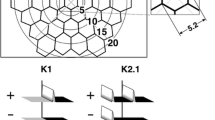Abstract
The photopic, focal electroretinogram elicited by sinusoidal modulation (8 Hz) of the luminance of a uniform field (flicker electroretinogram) presented in the macular region contains two main components: the first harmonic at the stimulus frequency (1F) and the second harmonic at twice the stimulus frequency (2F). Physiologic and clinical studies have demonstrated that the 1F originates in the outer retina, whereas the 2F has multiple postreceptoral sources, with a contribution of the innermost retina. The 2F, unlike 1F, is selectively altered in amplitude and phase in the early stages of optic neuritis and glaucoma. Both 1F and 2F are altered in maculopathies. An additional property of the focal electroretinogram is that the 2F, unlike 1F, has a very limited summation area (i.e., the function relating 2F amplitude with stimulus area is saturated for central stimulus sizes of the order of the macular region). This overrepresentation of the macular activity suggests that the 2F component of the flicker electroretinogram may provide a specific macular test even for full-field stimuli presented through opacities of the optical media.
Similar content being viewed by others
References
Van der Tweel LH. Some problems in vision regarded with respect to linearity and frequency response. Ann NY Acad Sci 1961; 89: 829–56.
Gouras P, Gunkel RD. The frequency response of normal, rod achromat and nyctalope ERGs to sinusoidal monochromatic light stimulation. Doc Ophthalmol Proc Ser 1964; 28: 137–50.
Porciatti V, Falsini B, Fadda A, Bolzani R. Steady-state analysis of the focal ERG to pattern and flicker: Relationship between ERG components and retinal pathology. Clin Vision Sci 1989; 4: 323–32.
Odom JV, Reits D, Burgers N, Riemslag FCC. Flicker electroretinograms: A system analytic approach. Opt Vision Sci 1992; 69: 106–16.
Burns SA, Elsner AE, Kreitz MR. Analysis of nonlinearities in the flicker ERG. Opt Vision Sci 1992; 69: 95–105.
Spekreijse H, Estevez D, Van der Tweel LH. Luminance responses to pattern reversal. Doc Ophthalmol Proc Ser 1973; 10: 205–11.
Riemslag FCC, Ringo JL, Spekreijse H, Verduyn Lunel H. The luminance origin of the pattern ERG in man. J Physiol (Lond) 1985; 363: 191–209.
Maffei L, Fiorentini A. Pattern visual evoked potentials and electroretinograms in man and animals. In: Desmedt JE, ed. Visual evoked potentials. Amsterdam: Elsevier, 1990; 25–33.
Baker CL, Hess RR, Olsen BT, Zrenner E. Current source density analysis of linear and non-linear components of the primate electroretinogram. J Physiol (Lond) 1988; 407: 155–76.
Falsini B, Colotto A, Porciatti V, Buzzonetti L. Coppé L, De luca L. Macular flicker- and pattern ERGs are differently affected in ocular hypertension. Clin Vision Sci 1991; 6: 423–9.
Falsini B, Bardocci A, Porciatti V, Bolzani R, Piccardi M. Macular dysfunction in multiple sclerosis revealed by steady-state flicker and pattern ERGs. Electroencephalogr Clin Neurophysiol 1992; 82: 53–9.
Porciatti V, Falsini B. Generators of the steady-state flicker and pattern ERG: A clinical approach. Submitted.
Porciatti V, Burr DC, Morrone C, Fiorentini A. The effects of ageing on the pattern electroretinogram and visual evoked potential in humans. Vision Res 1992; 32: 1199–290.
Brindley GS, Westheimer G. The spatial properties of the human electroretinogram. J Physiol, 1965; 170: 518–37.
Biersdorf WR. The clinical utility of the foveal electroretingram: A review. Doc Ophthalmol 1989; 73: 313–27.
Fiorentini A, Maffei L, Pirchio M, Spinelli D, Porciatti V. The ERG in response to alternating gratings in patients with diseases of the peripheral visual pathway. Invest Ophthalmol Vis Sci 1981; 21; 490–3.
Marmor MF, Arden Gb, Nilsson SEG, Zrenner E. Standard for clinical electroretinography. Arch Ophthalmol 1989; 107: 816–9.
Regan D. Some characteristics of average steady-state and transient responses evoked by modulated light. Electroencephalogr Clin Neurophysiol 1966; 20: 238–48.
Hess RF, Baker CL, Zrenner E, Schwarzer J. Differences between electroretinograms of cat and primate. J Neurophysiol 1986; 56: 747–68.
Falsini B, Minnella A, Buzzonetti L, Merendino E, Porciatti V. Focal electroretinograms to flicker and pattern in lamellar macular holes. Doc Ophthalmol 1992; 79: 99–108.
Ghirlanda G, Di Leo MAS, Caputo S, Falsini B, Porciatti V, Marietti G, Greco AV. Detection of inner retina dysfunction by steady-state focal electroretinogram to pattern and flicker in early IDDM. Diabetes 1991; 40: 1122–7.
Author information
Authors and Affiliations
Corresponding author
Rights and permissions
About this article
Cite this article
Porciatti, V., Moretti, G., Ciavarella, P. et al. The second harmonic of the electroretinogram to sinusoidal flicker: Spatiotemporal properties and clinical application. Doc Ophthalmol 84, 39–46 (1993). https://doi.org/10.1007/BF01203281
Accepted:
Issue Date:
DOI: https://doi.org/10.1007/BF01203281




